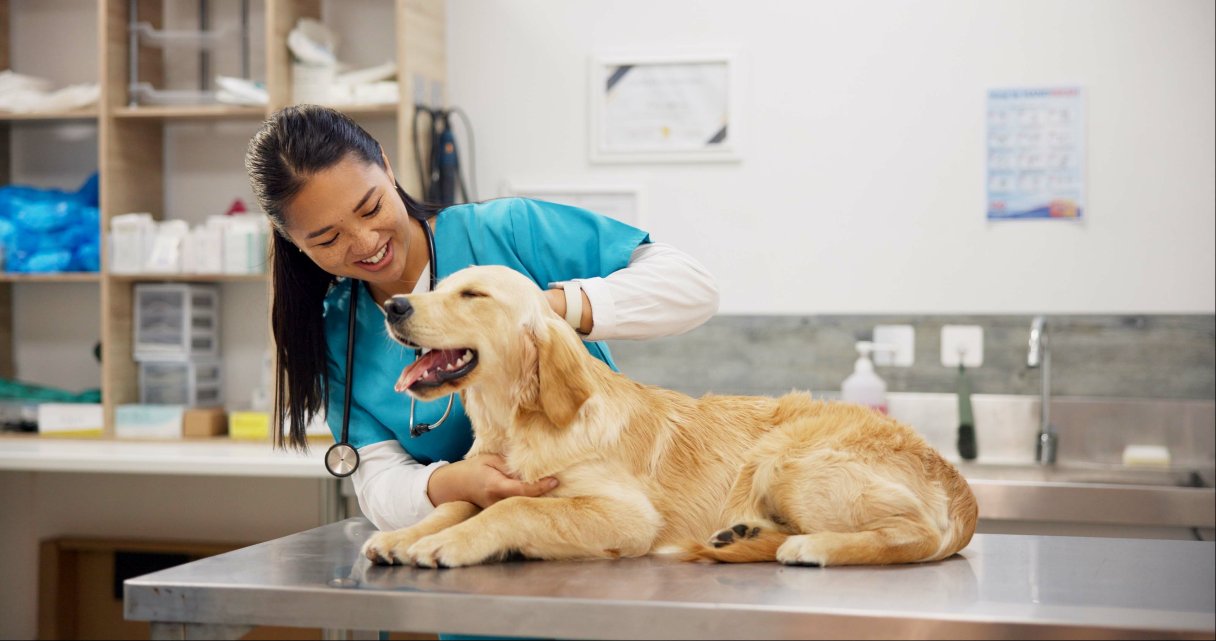When petting your pup, have you noticed a cauliflower-like lesion on their skin? While these lesions may look alarming, most are not problematic. Dog warts, also known as viral papillomas, are a common concern for pet parents, especially those with young dogs. In fact, warts are considered the second most frequent skin tumors in dogs under 1 year of age.1
What Are Dog Warts?
Dog warts are caused by a canine papillomavirus (CPV) and are typically benign (noncancerous).2
Twenty-four types of CPVs have been identified in dogs. They can affect the skin or mouth or, in some cases, both. The lesions pet owners commonly call dog warts are caused by CPV 1 and CPV 2.1
They are most often found on a dog's lips and muzzle but can also occur on the eyelids, between the toes and on other parts of the body. Viral papillomas can occur as a single lesion but most commonly appear in groups. The growths are round and have a rough surface that resembles a cauliflower.3
Types
Dog warts are usually classified into four kinds:4
- Canine mucous membrane papillomatosis. Multiple warts appear on the lips, muzzle and possibly the eyelids. If the dog’s mouth is severely affected, they may have difficulty chewing. Young dogs are most often affected with this type of wart.
- Digital papillomas. These warts grow on the foot pads and between the toes. They tend to be painful and may develop into cancer.3
- Skin warts. These lesions are more frequently solitary and develop in older dogs. Cocker spaniels and Kerry blue terriers have an increased likelihood for skin warts.
- Skin inverted papilloma. Young adult dogs are most commonly affected, and the lesions appear on the lower abdomen.
Transmission
Viral papillomas are transmitted when your pup encounters an infected dog or virus-contaminated items, such as toys, bedding or food bowls. Your dog must have a skin lesion or condition to become infected, as healthy skin is not susceptible.3
Dogs with an immature or suppressed immune system are more predisposed, which is why dog warts most commonly affect young dogs and puppies. If your dog is on oral cyclosporine to treat an immune-mediated disease, they may also be more susceptible.3
After exposure, it can take one to two months for dog warts to appear. Once the lesions regress, the affected dog is no longer contagious, and recovered dogs can’t be infected with the same virus strain. However, this doesn’t mean your four-legged friend won’t get viral papillomas again because there are several viral strains.3
Diagnosis
If your dog’s viral papilloma has the typical cauliflower-like appearance, your veterinarian may be able to diagnose the condition without any testing. However, if there is any uncertainty, a fine needle aspiration (FNA) is necessary to make a definitive diagnosis.
This procedure involves removing cells from the tumor using a needle and syringe. A veterinary pathologist evaluates the sample under a microscope to make the diagnosis. If the results from the FNA are unclear, a biopsy may be needed. Since viral papillomas are typically small, the entire tumor will likely be removed during the procedure.
In most cases, the prognosis for dogs with warts is excellent since the tumors are typically benign and usually resolve spontaneously.3 Young dogs and immunocompromised pets may take longer to clear the infection.
Dog Wart Treatment Options
In some cases, warts disappear on their own without treatment. Regression typically takes one to two months, but some warts persist for two years before regressing.1 Warts may require veterinary removal if they interfere with eating, become inflamed or infected or don’t regress in an acceptable time frame — about two months.3
The most common treatment for dog warts is surgical removal. Other options include:3
- Azithromycin. This oral antibiotic is sometimes used to treat dogs with multiple warts.
- Crushing. In some cases, crushing the growths can stimulate the dog’s immune system to cause the warts to regress.
- Cryogenic removal. The lesions can be frozen using liquid nitrogen.
- Interferon. This immune-modifying agent used to treat severe cases of warts in humans is sometimes used in dogs. However, the treatment is expensive, and results are inconsistent.
After dog wart removal, pet owners must keep the incision site clean and dry and prevent their pup from licking, biting or scratching at the area.
How Much Does Dog Wart Removal Cost?
The cost to remove your dog’s warts can vary depending on the location and number of warts, the removal method used, whether the warts are removed by a general practitioner or a specialist and where you live. The cost for a biopsy and histopathology to diagnose a viral papilloma will likely be about $500. Surgery performed by a general practitioner typically costs between $300 and $1,000, but if more extensive surgery is needed, you may have to pay up to $2,500.5
Does Pet Insurance Cover Dog Warts?
Some accident and illness pet insurance plans cover viral infections, including CPV. Pet insurance may not cover viral papillomas if the condition occurs before you purchase a policy or if treatment is not medically necessary.6
Whether you have pet insurance or not, you may need help paying for your dog's wart removal. Popular financing options include:
- Personal pet care loan
- Pet savings account
- Veterinary hospital payment plans
- CareCredit credit card
Dog warts may not be attractive, but the good news is that they typically won’t cause a serious health problem for your four-legged friend. Contact your veterinarian if your pup has any new concerning skin lesions.
Frequently Asked Questions About Dog Warts
Do you still have questions about dog warts? Here are answers to commonly asked questions about them.
CareCredit Credit Card Financing for Dogs
The CareCredit credit card provides a convenient way to pay for your dog's vaccinations and other health and wellness expenses, including exams, medications and products at providers in the CareCredit network.* Continue your wellness journey by downloading the CareCredit Mobile App. You can find a provider on the go, manage your CareCredit account and easily access the Well U blog for more great articles, podcasts and videos. Use our Acceptance Locator to find a veterinarian that accepts CareCredit to help keep your pet healthy and happy for a lifetime of love.
In addition to pet care, you can also use your CareCredit credit card for dentistry, cosmetic, vision, hearing, health systems, dermatology, pharmacy purchases, spa treatments and so much more within the CareCredit network. How will you invest in your health and wellness next?
Author Bio
Angela Beal, D.V.M., has more than 20 years of experience as a veterinarian. Leveraging her background in private practice and academia, she uses her passion for writing to convey information to pet owners to help them keep their pets healthy and happy.







